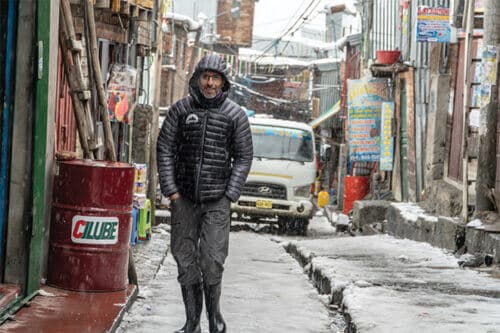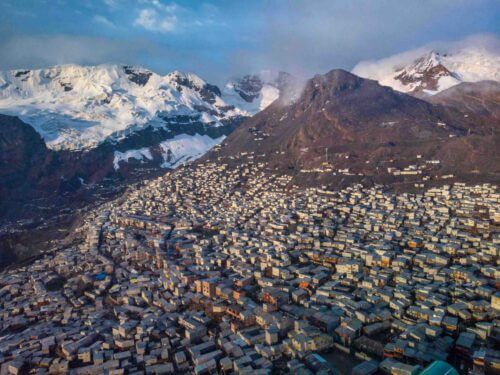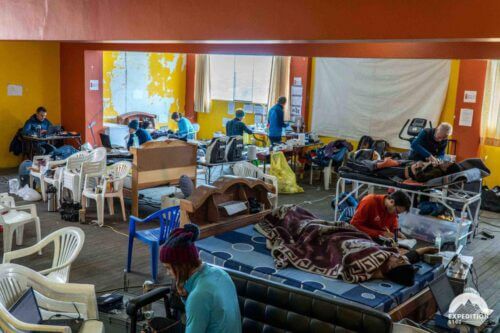A Weizmann Institute of Science scientist joined the expedition to the Andes Mountains in Peru in order to check how changes in oxygen levels at different altitudes affect the biological clocks in our bodies

Only the one who breathes road dust will get to inhale the air of the peaks"
La Rinconada in the Andes Mountains in Peru is the highest permanent settlement in the world - and also one of the hardest places to live. The residents of this town, most of them poor miners who came to the place hoping to get rich working in the nearby gold mine, are faced not only with deplorable living conditions and a lot of environmental pollution, but also with extremely rare oxygen, which at an altitude of 5,300 meters reaches only half of its density in the air at sea level. Prof. Gad Asher from the Weizmann Institute of Science recently joined a group of scientists from France - "Expedition 5300” - who stayed in La Rinconada both for scientific purposes - to study how the local residents adapt to the lack of oxygen - and for humanitarian purposes: to initiate projects to improve their living conditions. Prof. Asher, on the other hand, made it his goal to investigate the researchers: to check how the members of the expedition themselves were affected by the extreme lack of oxygen.
Prof. Asher and his research group in the Department of Biomolecular Sciences previously published a pioneering study that revealed that oxygen affects the biological clocks that operate in every cell of our body in "circadian" rhythms, i.e. 24-hour cycles. It has long been known that these circadian clocks - which regulate the sleep cycle, the secretion of many hormones and many other body functions - are affected by sunlight, temperature and dietary habits, but Prof. Asher's group was the first to show that oxygen levels also affect the regulation of these clocks and that Changes in oxygen levels can "reset" the clocks and bring them back or out of sync. This groundbreaking research was carried out in cell cultures and in mice. Now "Expedition 5300" provided the opportunity to investigate the effect of different oxygen levels on the circadian clocks in the human body.

Fear of heights
The number of residents in La Rinconada swelled over the years to more than 50 thousand along with the rising price of gold - the price of the commodity has jumped 30 times in the last 50 years. But this makeshift town, bordering a glacier, was never planned to be a permanent settlement: it has neither a sewage system, nor running water, nor hospitals. Most of the residents live in shacks without heating; The waste piles up everywhere and decomposes slowly due to the thinness of oxygen in the air, and the water sources are polluted as a result of the seepage of the mercury used to separate the gold from the rocks. The miners do not receive salaries - instead, once a month they are allowed to keep the rocks they dug that day, including the gold inside. Despite the dreams of getting rich, the precious metal is not found in these rocks but only in tiny amounts.
The members of the French delegation, led by Dr. Samuel Verges from the University of Grenoble in the Alps, established a temporary laboratory in La Rinconada in September 2019 for the study of chronic altitude sickness with the intention of also initiating humanitarian projects for the benefit of the local population. Prof. Asher joined "Expedition 5300" for three weeks on his second trip to La Rinconada - in February 2020.
This makeshift town, bordered by a glacier, was never planned to be a permanent settlement: it has neither a sewage system, nor running water, nor hospitals (Axel PITTET – Expedition 5300©)
The scientists stopped on the way for a few days in the city of Puno on Lake Titicaca, at an altitude of 3,800 meters, to acclimatize to the altitude. Still, when they arrived at the town of the gold miners, all members of the expedition suffered from symptoms of lack of oxygen: fatigue bordering on exhaustion and in some cases even sleep apnea, typical of severe altitude sickness. Despite the difficult conditions, the members rallied to participate in Prof. Asher's research: he took blood samples from them and from himself every four hours for a day - first at sea level when they arrived in Peru, then at an altitude of 3,800 meters and at an altitude of 5,300 meters. The hardships of life in La Rinconada also had advantages, at least from the research aspect: due to the physical symptoms and the lack of tempting options for eating outside, the members of the expedition ate all meals together and went to bed at the same time - so that a uniform agenda was created that is particularly suitable for the study of circadian clocks.
When the blood samples from Peru arrive in Israel, Prof. Asher will check if and how the changes in oxygen levels affected the cyclical expression of genes and cyclical fluctuations in different levels of substances in the body. In fact, Prof. Asher's laboratory has previously shown in mice that a lack of oxygen disrupts the biological clocks, and does so differently in different tissues, so that it causes them to "tick" without coordination between them. In other words, it violates the body-wide coordination between the clocks, which is essential for the proper functioning of the body.

It is now known that there is a connection between various respiratory diseases, including asthma, chronic obstructive pulmonary disease (COPD) and sleep apnea, and a cyclical decrease in oxygen supply - which probably indicates disruptions in the activity of the circadian clocks. The unique experimental conditions, such as those made possible in La Rinconada, may advance the understanding of the disruptions in these and other diseases and generally advance the understanding of the activity of the biological clocks in the human body.
Scientific numbers: up to 40% of the genes in the human body are expressed according to a circadian pattern, in 24-hour cycles.
More of the topic in Hayadan:

4 תגובות
If the percentage of oxygen in the air is constant, then its thinness is equal to the thinness of the air - and hence if the air concentration drops by 50%, so does the oxygen concentration.
If the percentage of oxygen in the air is constant, then its thinness is equal to the thinness of the air - and hence if the air concentration drops by 50%, so does the oxygen concentration.
Elevation - must be done with stops: in Nepal, travelers in the Himalayas are told not to climb more than 1000 meters per day, and must stay at the new altitude 24 hours before continuing the ascent, for fear of altitude sickness. This disease - whose symptoms are a strong headache, hallucinations, visual disturbances (blinding from relatively weak light), and inability to sleep (disruption of the circadian clock?) - among other things - can lead to death, and the only cure for it: descent to a lower altitude (or a pressure chamber, which is not usually found in such areas). According to the article - the expedition climbed 1500 m in one day.
interesting and important,
It's only appropriate that everywhere there is a reference to the "oxygen levels"
or to "oxygen deficiency" or "dilute oxygen",
It will be written instead of air oxygen,
Because the percentage/concentration of oxygen in the air is at different altitudes
does not change
What changes is the "closeness" of the air,
Air is thin, so it is clear that all its components are thin,
and therefore to get the amount of oxygen needed by the body
Inhale/take in more air,